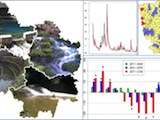Étienne Brulebois PhD thesis
 Impacts of climate change on water availability in Burgundy: quantitative and qualitative aspects
Impacts of climate change on water availability in Burgundy: quantitative and qualitative aspects
Defended on the 21st December 2016
Funding: 50% Burgundy regional council, 50% water agencies (1/3 Loire-Bretagne, 1/3 Rhône-Méditerranée-Corse, 1/3 Seine-Normandie)
Supervisor: Philippe Amiotte Suchet
Started in November 2013
Summary
Numerous studies dealing with climate change impacts on water ressources have been done at global scale, but the moderated size watersheds scale is less studied. The Burgundy region is located over several hydrographical basins (Seine, Loire and Rhône river), and provides a great diversity of hydrogeological and climate contexts. For these reasons, impacts of climate change on water resources are expected to be very different in space, and require an entire hydroclimatic modelling chain at local scale to be assessed.
The main objective of this thesis consisted of the implementation of a this modelling tool at the moderated size watersheds scale of Burgundy. In this way, several watersheds and two hydrological models have been chosen: a global and empirical rainfall-runoff model (GR4J) and a physical based and semi-spatialised model (SWAT). These two models allow us to assess every aspects of climate change impacts: quantitative (streamflow and spatialised ressources) and qualitative impacts. Models have been calibrated, including a cross calibration/validation test in climate contrasted periods, to confirm their robustness. A disaggregation of global climate data has been done in order to feed models during projection.
Observations analysis highlighted a climate shift (in Burgundy as well as over the entire french territory), resulting in a modification of hydrological regime. Models projection over the XXIth century showed i) not much evolution of annual streamflow, but an accented seasonality, with an increase of winter streamflow, and a decrease of summer streamflow, linked with the rainfall regime and the evapotranspiration increase, ii) drought flow indices showing an increase of severity of the drought flow period, iii) a decrease in water quality. In order to explore the capacities of the modelling chain, several sensibility tests have been done, based on management practices scenarios.
Keywords
climate change, hydrological modelling, Burgundy, GR4J, SWAT
- extrait:
- lien_externe:
- kc_data:
- a:8:{i:0;s:0:"";s:4:"mode";s:0:"";s:3:"css";s:0:"";s:9:"max_width";s:0:"";s:7:"classes";s:0:"";s:9:"thumbnail";s:0:"";s:9:"collapsed";s:0:"";s:9:"optimized";s:0:"";}
- kc_raw_content:
 Impacts of climate change on water availability in Burgundy: quantitative and qualitative aspects
Impacts of climate change on water availability in Burgundy: quantitative and qualitative aspectsDefended on the 21st December 2016
Funding: 50% Burgundy regional council, 50% water agencies (1/3 Loire-Bretagne, 1/3 Rhône-Méditerranée-Corse, 1/3 Seine-Normandie)
Supervisor: Philippe Amiotte Suchet
Started in November 2013
Summary
Numerous studies dealing with climate change impacts on water ressources have been done at global scale, but the moderated size watersheds scale is less studied. The Burgundy region is located over several hydrographical basins (Seine, Loire and Rhône river), and provides a great diversity of hydrogeological and climate contexts. For these reasons, impacts of climate change on water resources are expected to be very different in space, and require an entire hydroclimatic modelling chain at local scale to be assessed.
The main objective of this thesis consisted of the implementation of a this modelling tool at the moderated size watersheds scale of Burgundy. In this way, several watersheds and two hydrological models have been chosen: a global and empirical rainfall-runoff model (GR4J) and a physical based and semi-spatialised model (SWAT). These two models allow us to assess every aspects of climate change impacts: quantitative (streamflow and spatialised ressources) and qualitative impacts. Models have been calibrated, including a cross calibration/validation test in climate contrasted periods, to confirm their robustness. A disaggregation of global climate data has been done in order to feed models during projection.
Observations analysis highlighted a climate shift (in Burgundy as well as over the entire french territory), resulting in a modification of hydrological regime. Models projection over the XXIth century showed i) not much evolution of annual streamflow, but an accented seasonality, with an increase of winter streamflow, and a decrease of summer streamflow, linked with the rainfall regime and the evapotranspiration increase, ii) drought flow indices showing an increase of severity of the drought flow period, iii) a decrease in water quality. In order to explore the capacities of the modelling chain, several sensibility tests have been done, based on management practices scenarios.
Keywords
climate change, hydrological modelling, Burgundy, GR4J, SWAT
